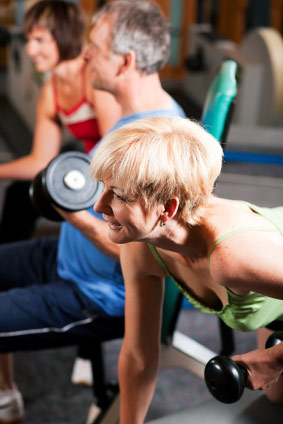Senior Fitness
Does senior fitness really matter? Surely by the time you start collecting your pension, the last thing you need is to be working out? That was certainly the view in the past – there was a general belief that rapid deterioration of the body was an inevitable part of growing older, and that people should just kick back and accept it.  These days, however, it is not uncommon for seniors to run marathons, compete in long distance triathlons, or take on challenges like hiking the Appalachian Trial. Are these people genetic freaks, or is it normal for seniors to be fit, healthy, and active? These days, however, it is not uncommon for seniors to run marathons, compete in long distance triathlons, or take on challenges like hiking the Appalachian Trial. Are these people genetic freaks, or is it normal for seniors to be fit, healthy, and active?
Fortunately this is a growing area for researchers, and the evidence they are uncovering is incontrovertible – not only can exercise slow down the symptoms of aging, it can actually reverse them. Indeed, many of the symptoms we normally associate with aging are simply the result of modern, sedentary lifestyles. So what happens if you become less active as you grow older? The changes to the body can be profound, and include: Loss Of Muscle Mass in Seniors Muscle mass decreases rapidly as you age – once you pass 30 you start to lose around 3%-5% of your muscle mass per decade. After 50 this increases to 1%-2% per year!1 Now you may be thinking, big deal, I don’t want to enter the Mr. Universe competition – but muscle mass isn’t about having big muscles, it is about mobility and independence, being able to easily do the things you have always taken for granted, everyday things like carrying heavy groceries or climbing stairs. Endurance Endurance also decreases as you age, and this decline shows a direct correlation to mortality rates. Researchers have looked at the relationship between the speed at which 70-79 year olds walked a quarter of a mile, and their risk of premature mortality.2 What they found was that the slower people walked, the higher their mortality risk from illnesses such as cardiovascular disease. Flexibility Watch any senior move and it is clear that flexibility decreases rapidly with age. This makes simple tasks more difficult, whether it is cutting your toenails or reaching up to a high shelf! Balance A key element of senior fitness, balance is vital for older people – loss of balance is a major factor in the falls suffered by seniors. The Center for Disease Control and Prevention (CDC) reports that among Americans over 65, falls account for 87% of all fractures and are the second leading cause of spinal cord and brain injury.3 Benefits and Solutions for Senior Fitness The problem is clear, but what about the solution? Fortunately, it’s never too late to get back in shape. Researchers working in nursing homes have found that with regular exercise, patients as old as 98 can make dramatic improvements in strength, endurance, flexibility and balance! How can exercise help? There is evidence that regular exercise can help the senior's fitness levels in numerous ways, including: • Mortality and Heart Health: According to a study that followed a group of men and women for more than 40 years4, people age 50 and older who engage in regular physical activity live longer and have less heart disease. • Overall health: The National Institutes of Health (NIH) report that moderate exercise and physical activity improves the health of seniors who are frail, or who have diseases that accompany aging. • Dementia: Exercising regularly can help prevent or delay many diseases and disabilities, including dementia. Indeed, a University of Washington study has shown that regular exercise reduces the risk of dementia and Alzheimer's disease by up to 40%.5 • Brain function: Researchers have found that fitter seniors had higher scores on tasks like coordination, scheduling, planning, and memory. • Mood: With research suggesting that as many as 14% of males and 18% of females over age 55 are depressed, it is worth noting that exercise is one of the most effective ways to alleviate symptoms of depression So what are the recommendations for senior fitness? The American College of Sports Medicine have recently published guidelines for physical activity for seniors6. Their recommendations are: Aerobic/Cardio Exercise Cardio exercise includes activities such as dancing, walking, running, swimming, biking, and exercise classes. The ACSM recommends: • Moderate-intensity aerobic exercise five days per week for at least 30 minutes – or
• Vigorous aerobic exercise for a minimum of 20 minutes three times per week. Moderate intensity exercise should make you feel "warm and slightly out of breath," while vigorous exercise should make you feel "out of breath and sweaty.” Resistance Exercise Resistance exercise help to strengthen muscles – this can include weight training, resistance bands, or body weight exercises. The recommendation is: • Perform resistance exercises twice per week, on non-consecutive days They suggest that you should perform at least 8 – 10 exercises that work your major muscle groups. Flexibility Activities that maintain or increase flexibility should be performed for at least ten minutes, twice per week. This can include stretching, or activities like yoga or Pilates. Balance Seniors should regularly perform exercises that maintain or improve balance – again, yoga is an excellent choice. Alternatively, do some research online – you’ll find lots of balance exercises demonstrated. With senior fitness so clearly crucial for maintaining good health and independence, regular exercise should be a part of every senior’s life.
1http://www.weightlossforall.com/metabolism-affects-weightloss-x.htm
2http://www.medicinenet.com/senior_exercise/page2.htm
3http://www.cdc.gov/dhdsp/cdcynergy_training/content/ 4Archives of Internal Medicine 2005;165:2355-2360
5Dr Eric Larson; Annals of Internal Medicine, 2006 6http://www.acsm.org/AM/ Back to top of Senior Fitness |